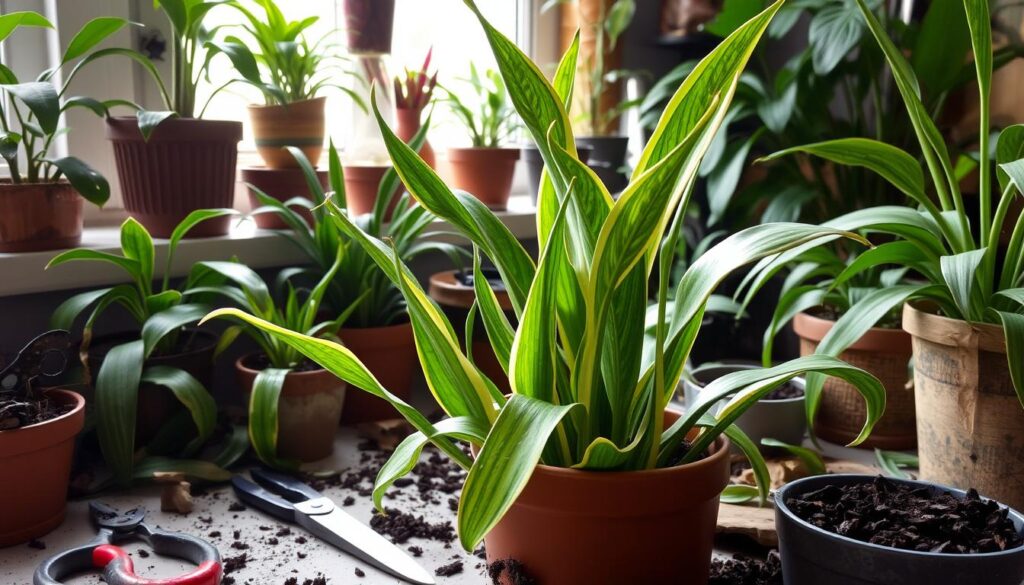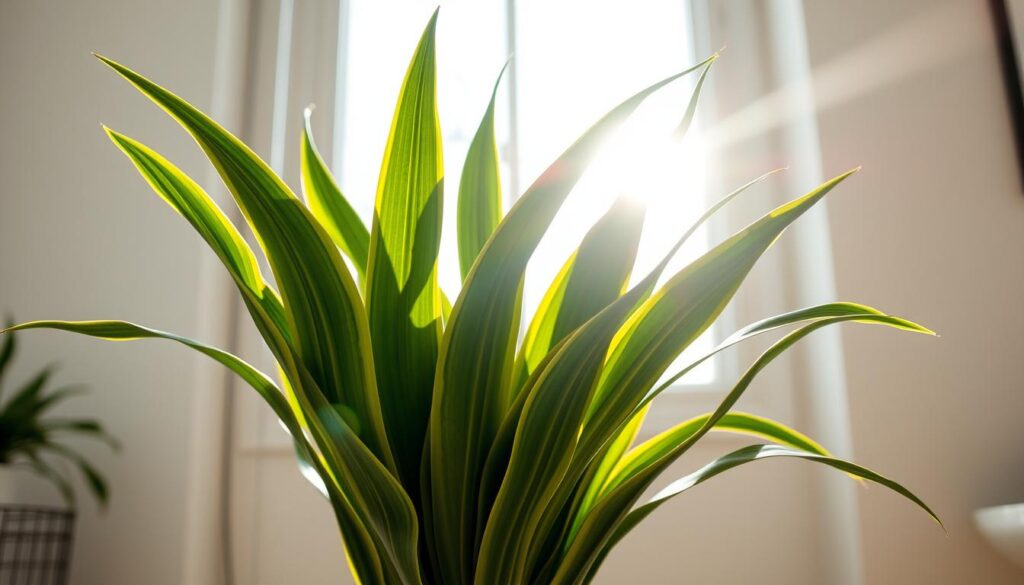The snake plant, also known as mother tongue or Sansevieria is more than an ornamental plant in your house as it serves the purpose of improving the quality of the air With its resilient dark green leaves and being nearly maintenance free it easily has become one of the most popular plants for homes If you wish to have plants in your indoors but don’t wish to tend to them regularly, the snake plant is the one for you.
In this write up we will provide you with a few techniques targeted at improving the appearance and structure of your snake plants. This article will help you whether you are new to plant care or have some experience when it comes to taking care of your plants.
Did you know the snake plant also known as Sansevieria is super popular Its known for its deals with sharp leaves and can withstand varying growing conditions For someone who loves gardening Snake plants I can’t wait to explain to you how to take care of this plant.
Understanding Snake Plant Basics and Benefits
Snake plants also known as Sansevieria are loved by many indoor gardeners. They are easy to care for and come in many varieties. Each variety has its own special look and benefits.
Common Snake Plant Varieties
The Sansevieria trifasciata is a favorite for its colorful leaves. The Sansevieria cylindrica is loved for its tall, cylindrical leaves. These plants are elegant and can grow well in different light conditions. They are great for both new and experienced plant lovers.
Health Benefits of Growing Snake Plants Indoors
Snake plants are not just pretty; they also clean the air. They remove harmful toxins like benzene and formaldehyde. They also release oxygen at night, which is good for bedrooms.
Snake Plant Growth Patterns
Snake plants are easy to care for and can grow in many conditions. They grow slowly, with their leaves getting taller over time. Knowing how they grow helps gardeners take good care of them.
Learning about snake plants helps gardeners appreciate them more. They offer many varieties, clean the air, and are easy to care for. They are a great choice for any indoor space.
How to Care for a Snake Plant: Essential Guidelines
Caring for a snake plant is easy. They are very resilient and adaptable. Knowing about light, water, and soil is key. This helps your snake plant thrive indoors.
Snake plants can handle many lighting conditions. They do well in both direct and indirect sunlight. This makes them perfect for those with little natural light. Just watch your plant and adjust the light as needed.
- They like well-draining soil and can go without water for a bit. But, they still need regular watering to keep the soil moist.
- Water them every 2-3 weeks when the soil is dry. This helps prevent root rot.
- Don’t overwater. It can harm your plant. Check the soil moisture and adjust your watering schedule.
Temperature is also important. Snake plants love warm, humid places. They do best between 65°F and 85°F. Keep them away from cold drafts and sudden temperature changes.
“Snake plants are one of the most resilient and low-maintenance houseplants you can grow, making them a great choice for both novice and experienced plant enthusiasts.”
Follow these tips to keep your Sansevieria healthy and green. The secret is finding the right balance of light, water, and temperature.
Optimal Light Requirements for Thriving Snake Plants
Snake plants, also known as Sansevieria, are known for their ability to adapt to different lighting. They do best in indirect or filtered snake plant light requirements. This makes them perfect for homes and offices with little natural light.
Direct vs Indirect Light Exposure
Snake plants can handle direct sunlight but do better with indirect or diffused snake plant sunlight needs. Direct sunlight can burn the leaves and make them turn brown. Indirect light, like from a north-facing window, is best. It gives the right amount of light without harming the plant.
Seasonal Light Adjustments
The light needs of snake plants change with the seasons. In spring and summer, they need a bit more snake plant light requirements. In fall and winter, when days are shorter, they need less. Moving your snake plant to get the right amount of indirect light all year helps it grow well.
Signs of Improper Light Conditions
- Leaves turning yellow or pale: Shows the plant is getting too much direct sunlight.
- Drooping or wilting leaves: Means the plant isn’t getting enough snake plant sunlight needs.
- Slow growth or lack of new leaves: Often means the plant isn’t getting enough light.
Knowing the snake plant light requirements and watching for these signs helps. This way, your snake plant will stay healthy and bright.
Proper Watering Techniques and Schedule
It’s key to water your snake plant right to keep it healthy. These plants can go without water for a while, making them great for beginners. But, it’s important not to water too much to prevent problems.
Water your snake plant every 2-3 weeks. Let the soil dry a bit before you water again. In winter, you can water once a month because the plant grows slower. Make sure to soak the soil well and let it drain out. Don’t let the plant sit in water to avoid root rot.
| Watering Schedule | Soil Moisture Level |
|---|---|
| Spring and Summer: Every 2-3 weeks | Allow soil to dry out slightly between waterings |
| Fall and Winter: Once a month | Allow soil to dry out more between waterings |
Check if your snake plant needs water by using the “finger test”. Stick your finger into the soil up to the first knuckle. If it’s dry, it’s time to water. Or, lift the pot. If it’s light, it’s time to water.

Remember, the main thing is to not overwater your snake plant. They can get root rot and other problems if the soil is too wet. By watering regularly and checking the soil, your snake plant will do well for a long time.
Soil Selection and Potting Requirements
As a snake plant lover, I know how key the right soil is. The snake plant soil needs are very specific for their growth and health. The best soil for snake plants is one that drains well and is light. It should also let air in and control moisture.
Best Soil Mixture Components
The perfect soil mix for snake plants includes:
- Potting soil or cactus/succulent mix
- Perlite or coarse sand for better drainage
- Compost or aged bark for organic matter
Drainage Considerations
Snake plants need good drainage to avoid root rot. Make sure the pot has lots of holes for water to drain. This keeps the roots from getting too wet.
Container Selection Tips
Choose a pot that’s just a bit bigger than the plant’s roots. Terracotta or ceramic pots are great. They help the soil dry faster, which means less chance of too much water.
“Providing the right soil and potting conditions is essential for the long-term health and vibrant growth of your snake plant.”
Effective Snake Plant Propagation Methods
Want to grow more snake plants or share them with friends? Snake plant propagation makes it easy. Learning how to propagate lets you share these plants and watch them grow in new places.
Leaf Cuttings: The Simple Approach
Leaf cuttings are a simple way to propagate snake plants. Pick a healthy leaf, cut it into pieces, and put the pieces in soil. With care and time, these pieces will grow roots and become new plants.
Division: Splitting for Success
Division works well for bigger snake plants. Take the plant out of its pot and split it into smaller parts. Each part should have roots and leaves. Plant these parts in separate pots and watch them grow.
| Propagation Method | Time to Root | Success Rate |
|---|---|---|
| Leaf Cuttings | 4-8 weeks | Moderate to High |
| Division | 2-4 weeks | High |
With the right methods and patience, you can grow more snake plants. Share these easy-to-care-for, air-purifying plants with your loved ones.

“Propagating snake plants is a rewarding way to expand your collection and share these resilient beauties with loved ones.”
Identifying and Treating Common Snake Plant Problems
As a snake plant lover, knowing about common issues is key. These plants are tough but can still get sick or have pests. By tackling snake plant problems early, you can keep your plant healthy and happy.
Disease Prevention and Treatment
Root rot is a big problem for snake plants. It happens when you water too much or the soil doesn’t drain well. To avoid this, water your plant only when the soil is dry. If leaves turn yellow or soft, act fast.
Take the plant out of its pot and check the roots. Cut off any bad parts. Then, put the plant in new soil that drains well.
Pest Management Solutions
Snake plants can get pests like spider mites, mealybugs, and scale insects. These pests can harm your plant’s leaves and health. To fight snake plant pests and diseases, check your plant often. Use a mild insecticidal soap or neem oil to treat any pests you find.
Troubleshooting Growth Issues
Snake plants might also have growth problems like yellow leaves or slow growth. These issues can come from bad lighting or too little water. Change how you care for your plant to fix these problems.
Snake plants are tough and can recover from many issues. By being careful and fixing snake plant problems early, your plant will stay beautiful for a long time.
| Common Snake Plant Problems | Causes | Solutions |
|---|---|---|
| Root Rot | Overwatering, poor drainage | Adjust watering schedule, repot in well-draining soil |
| Pest Infestations | Spider mites, mealybugs, scale insects | Treat with insecticidal soap or neem oil |
| Yellowing Leaves | Improper lighting, water stress | Adjust lighting, water more or less as needed |
Snake Plant Safety and Toxicity Concerns
Snake plants are great, but they can be harmful if eaten. They have saponins, which can make you feel sick. This includes nausea, vomiting, and diarrhea.
Keep snake plants away from kids and pets. They should not be on low tables or floors. Place them high up where they can’t get to them.
If a kid or pet eats a snake plant, get help right away. Even small problems can get worse. With care, you can still enjoy your snake plants safely.
FAQ
How do I care for a snake plant?
Snake plants are easy to care for. They need little attention to thrive. Here are some important tips:
What are the light requirements for a snake plant?
Snake plants can handle many light conditions. They can even grow in low light. But, they do best in bright, indirect light.
How often should I water my snake plant?
Snake plants can survive without water for a long time. Water them every 2-3 weeks. Make sure the soil is dry before watering again.
What type of soil do snake plants prefer?
They like well-draining, slightly acidic soil. A mix made for succulents or cacti works well.
Can I propagate my snake plant?
Yes, you can. Propagate them by leaf cuttings or division. It’s a good way to grow more or share with others.
Are snake plants toxic to pets?
Yes, they can be toxic to pets. Keep them away from curious animals.
How often should I repot my snake plant?
Repot them every 2-3 years or when they outgrow their pot. Use a pot that’s one size bigger.


